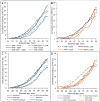Lifetime Risk of Atrial Fibrillation by Race and Socioeconomic Status: ARIC Study (Atherosclerosis Risk in Communities)
- PMID: 30002066
- PMCID: PMC6053683
- DOI: 10.1161/CIRCEP.118.006350
Lifetime Risk of Atrial Fibrillation by Race and Socioeconomic Status: ARIC Study (Atherosclerosis Risk in Communities)
Abstract
Background: Limited information exists on the lifetime risk of atrial fibrillation (AF) in African Americans and by socioeconomic status.
Methods: We studied 15 343 participants without AF at baseline from the ARIC (Atherosclerosis Risk in Communities) cohort recruited in 1987 to 1989 from 4 communities in the United States when they were 45 to 64 years of age. Participants have been followed through 2014. Incidence rates of AF were calculated dividing the number of new cases by person-years of follow-up. Lifetime risk of AF was estimated by a modified Kaplan-Meier method considering death as a competing risk. Participants' family income and education were obtained at baseline.
Results: We identified 2760 AF cases during a mean follow-up of 21 years. Lifetime risk of AF was 36% (95% confidence interval, 32%-38%) in white men, 30% (95% confidence interval, 26%-32%) in white women, 21% (95% confidence interval, 13%-24%) in African American men, and 22% (95% confidence interval, 16%-25%) in African American women. Regardless of race and sex, incidence rates of AF decreased from the lowest to the highest categories of income and education. In contrast, lifetime risk of AF increased in individuals with higher income and education in most sex-race groups. Cumulative incidence of AF was lower in those with higher income and education compared with their low socioeconomic status counterparts through earlier life but was reversed after age 80.
Conclusions: Lifetime risk of AF in the ARIC cohort was ≈1 in 3 among whites and 1 in 5 among African Americans. Socioeconomic status was inversely associated with cumulative incidence of AF before the last decades of life.
Keywords: atherosclerosis; atrial fibrillation; incidence; income; stroke.
© 2018 American Heart Association, Inc.
Figures



Comment in
-
Race and Socioeconomic Status Regulate Lifetime Risk of Atrial Fibrillation.Circ Arrhythm Electrophysiol. 2018 Jul;11(7):e006584. doi: 10.1161/CIRCEP.118.006584. Circ Arrhythm Electrophysiol. 2018. PMID: 30002068 Free PMC article. No abstract available.
References
-
- January CT, Wann LS, Alpert JS, Calkins H, Cigarroa JE, Cleveland JC, Jr, Conti JB, Ellinor PT, Ezekowitz MD, Field ME, Murray KT, Sacco RL, Stevenson WG, Tchou PJ, Tracy CM, Yancy CW. 2014 AHA/ACC/HRS guideline for the management of patients with atrial fibrillation. J Am Coll Cardiol. 2014;64:e1–e76. doi: 10.1016/j.jacc.2014.03.022. - DOI - PubMed
-
- Mozaffarian D, Benjamin EJ, Go AS, Arnett DK, Blaha MJ, Cushman M, de Ferranti S, Després JP, Fullerton HJ, Howard VJ, Huffman MD, Judd SE, Kissela BM, Lackland DT, Lichtman JH, Lisabeth LD, Liu S, Mackey RH, Matchar DB, McGuire DK, Mohler ER, 3rd, Moy CS, Muntner P, Mussolino ME, Nasir K, Neumar RW, Nichol G, Palaniappan L, Pandey DK, Reeves MJ, Rodriguez CJ, Sorlie PD, Stein J, Towfighi A, Turan TN, Virani SS, Willey JZ, Woo D, Yeh RW, Turner MB American Heart Association Statistics Committee and Stroke Statistics Subcommittee. Heart disease and stroke statistics—2015 update: a report from the American Heart Association. Circulation. 2015;131:e29–e322. doi: 10.1161/CIR.0000000000000152. - DOI - PubMed
-
- Lloyd-Jones DM, Wang TJ, Leip EP, Larson MG, Levy D, Vasan RS, D’Agostino RB, Massaro JM, Beiser A, Wolf PA, Benjamin EJ. Lifetime risk for development of atrial fibrillation. The Framingham Heart Study. Circulation. 2004;110:1042–1046. - PubMed
Publication types
MeSH terms
Grants and funding
LinkOut - more resources
Full Text Sources
Other Literature Sources
Medical

